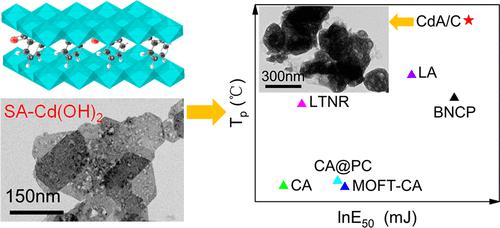当前位置:
X-MOL 学术
›
ACS Appl. Nano Mater.
›
论文详情
Our official English website, www.x-mol.net, welcomes your
feedback! (Note: you will need to create a separate account there.)
Efficient Synthesis of Nanoscale Cadmium Azide from Intercalated Cadmium Hydroxide for Nanoexplosive Applications
ACS Applied Nano Materials ( IF 5.3 ) Pub Date : 2023-02-03 , DOI: 10.1021/acsanm.2c05211 Long Li 1 , Zhenzhan Yan 1 , Li Yang 1 , Ji-Min Han 1 , Wenchao Tong 1
ACS Applied Nano Materials ( IF 5.3 ) Pub Date : 2023-02-03 , DOI: 10.1021/acsanm.2c05211 Long Li 1 , Zhenzhan Yan 1 , Li Yang 1 , Ji-Min Han 1 , Wenchao Tong 1
Affiliation

|
Due to its good sensitivity, detonation ability, and high-temperature resistance, cadmium azide is expected to be applied to microinitiating systems. Here we demonstrate an effective synthetic methodology (GAF-IH) to prepare nanoscale cadmium azide. A nanoscale mesoporous configuration is designed to construct azide precursor utilizing controlled self-assembly of inorganic and organic molecules followed by in situ carbonization crystallization. The nanoscale porous precursors can react with HN3 gas to form nanoscale cadmium azide composites (CdA/SA and CdA/C) in just 3 h, which takes much less time than traditional preparation methods of cadmium azide. The organic molecules and their carbonized skeletons can act as the carriers of nanoscale cadmium compounds to avoid agglomeration, as supporting materials for building HN3 azide gas channels, and as functional components in the nanoscale cadmium azide composites to influence their performance. CdA/C prepared by this route has favorable comprehensive properties, which not only has a high content of CdA (93.8%), indicating excellent detonation performance (tID < 10 μs), but also has good high-temperature resistance (Tp = 365 °C) and low electrostatic sensitivity (E50 = 1.76 J). Thanks to its nanoscale characteristics and outstanding performance, CdA/C has the potential to replace CA and modified CA in the application of microinitiating devices.
中文翻译:

从插层氢氧化镉中高效合成纳米级叠氮化镉用于纳米爆炸应用
叠氮化镉由于具有良好的灵敏度、爆轰能力和耐高温性,有望应用于微引发体系。在这里,我们展示了一种有效的合成方法 (GAF-IH) 来制备纳米级叠氮化镉。纳米级中孔配置旨在利用无机和有机分子的受控自组装,然后原位碳化结晶来构建叠氮化物前体。纳米级多孔前体可与HN 3反应气体在短短 3 小时内形成纳米级叠氮化镉复合材料(CdA/SA 和 CdA/C),这比传统的叠氮化镉制备方法花费的时间少得多。有机分子及其碳化骨架可以作为纳米级镉化合物的载体避免团聚,作为构建HN 3叠氮化物气体通道的支撑材料,作为纳米级叠氮化镉复合材料中的功能组分影响其性能。该路线制备的CdA/C具有良好的综合性能,不仅CdA含量高(93.8%),具有优异的爆轰性能(t ID < 10 μs),而且具有良好的耐高温性能(T p = 365 °C)和低静电敏感性(E 50 = 1.76 焦耳)。由于其纳米级特性和突出的性能,CdA/C在微引发装置的应用中具有替代CA和改性CA的潜力。
更新日期:2023-02-03
中文翻译:

从插层氢氧化镉中高效合成纳米级叠氮化镉用于纳米爆炸应用
叠氮化镉由于具有良好的灵敏度、爆轰能力和耐高温性,有望应用于微引发体系。在这里,我们展示了一种有效的合成方法 (GAF-IH) 来制备纳米级叠氮化镉。纳米级中孔配置旨在利用无机和有机分子的受控自组装,然后原位碳化结晶来构建叠氮化物前体。纳米级多孔前体可与HN 3反应气体在短短 3 小时内形成纳米级叠氮化镉复合材料(CdA/SA 和 CdA/C),这比传统的叠氮化镉制备方法花费的时间少得多。有机分子及其碳化骨架可以作为纳米级镉化合物的载体避免团聚,作为构建HN 3叠氮化物气体通道的支撑材料,作为纳米级叠氮化镉复合材料中的功能组分影响其性能。该路线制备的CdA/C具有良好的综合性能,不仅CdA含量高(93.8%),具有优异的爆轰性能(t ID < 10 μs),而且具有良好的耐高温性能(T p = 365 °C)和低静电敏感性(E 50 = 1.76 焦耳)。由于其纳米级特性和突出的性能,CdA/C在微引发装置的应用中具有替代CA和改性CA的潜力。

































 京公网安备 11010802027423号
京公网安备 11010802027423号